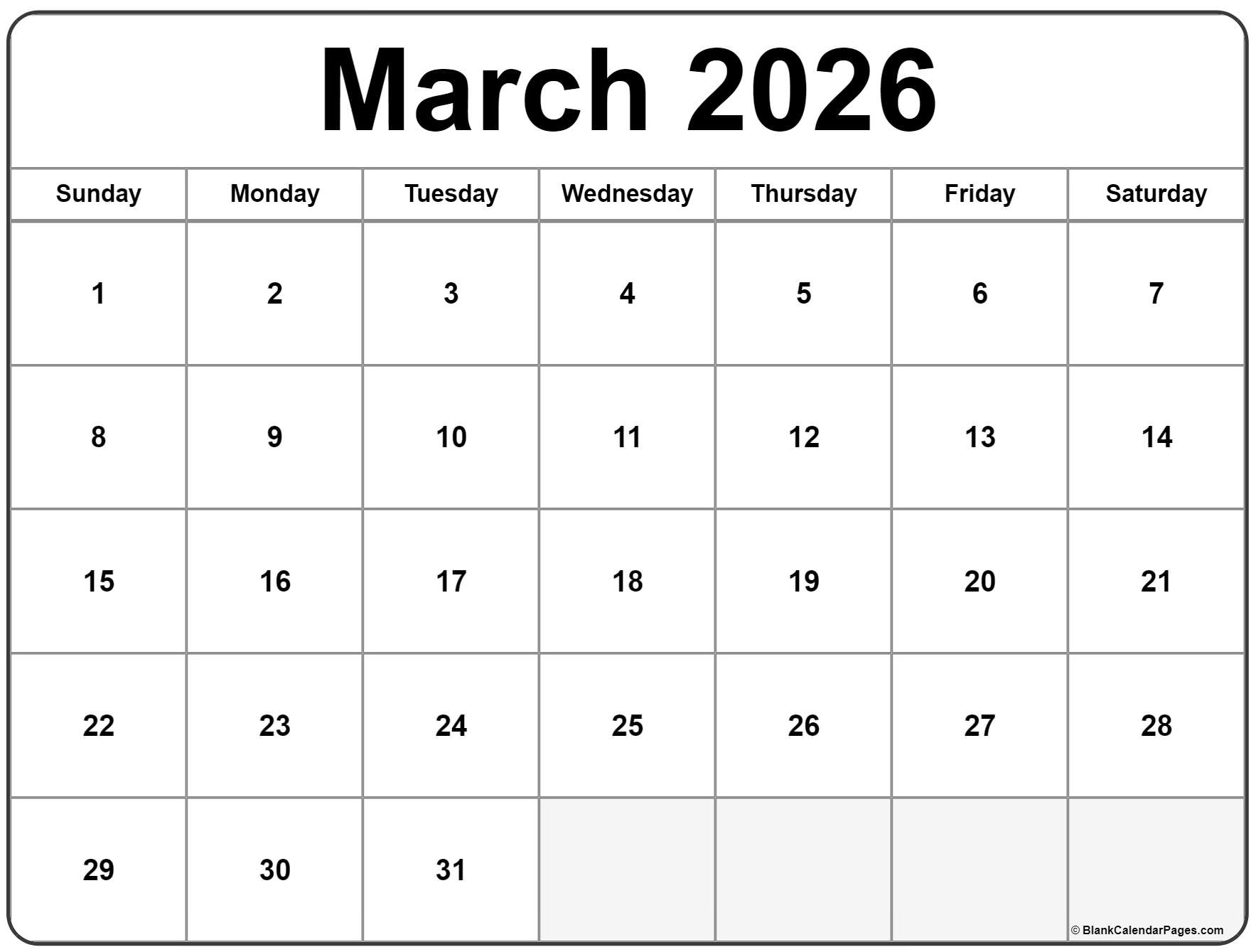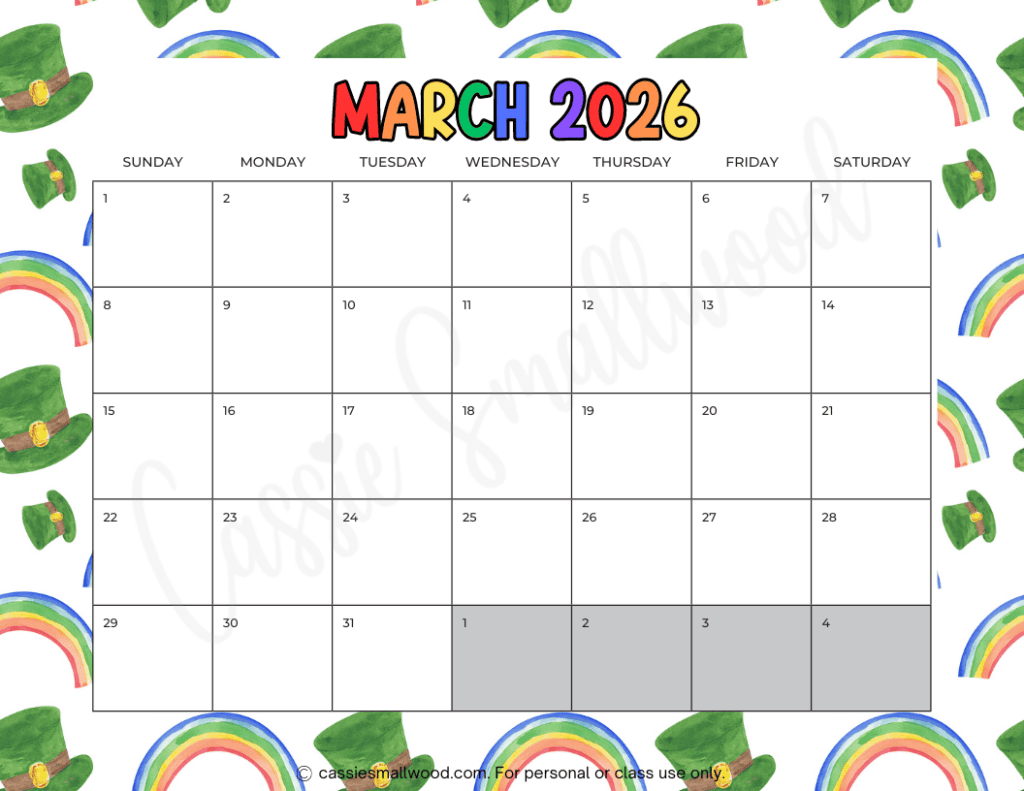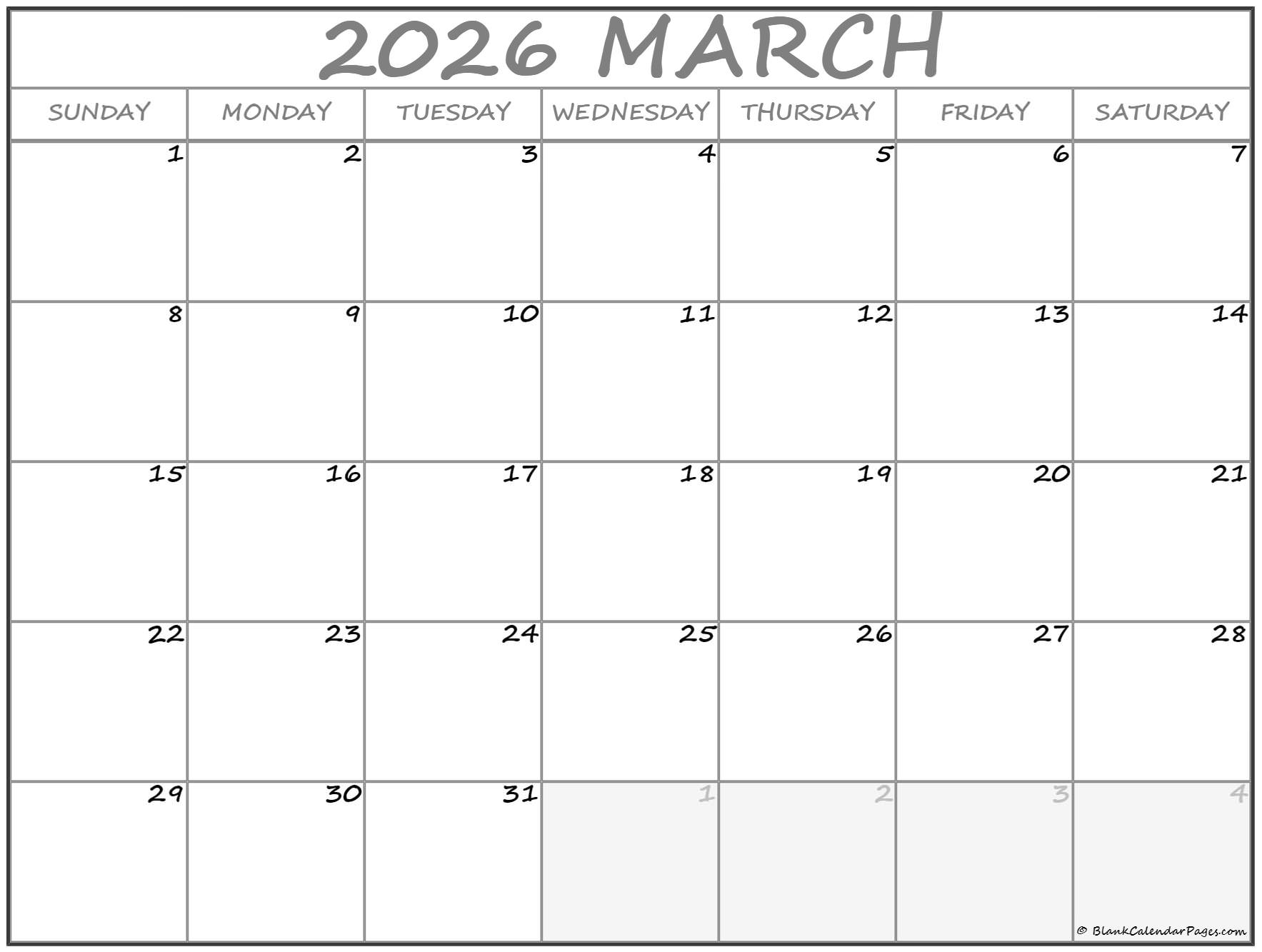
Introduction
monthly calendar 2026 march represents a significant subject within its field, encompassing a range of practices, traditions, or applications that shape daily life and broader cultural or professional landscapes. Understanding monthly calendar 2026 march provides clarity about its background, its present relevance, and the way it continues to influence various aspects of society. As a specific temporal framework, the calendar for March 2026 serves as more than just a sequence of days; it is a fundamental tool for organization, anticipation, and the coordination of activities across diverse sectors. Its utility extends from individual scheduling to large-scale institutional planning, making it an indispensable element in navigating the complexities of modern existence. The structured arrangement of days, weeks, and public holidays within this specific month offers a clear roadmap for personal and collective endeavors, fostering efficiency and foresight.
Definition and Origin of monthly calendar 2026 march
The concept of a monthly calendar, specifically for March 2026, refers to a systematic arrangement of days within that particular month, typically presented in a grid format that highlights weekdays, weekends, and often includes public holidays or significant observances. Fundamentally, it is a tool for chronological organization, designed to facilitate the tracking of time and the scheduling of events. The broader origin of calendars traces back to ancient civilizations, driven by the need to measure and record time for agricultural cycles, religious ceremonies, and administrative purposes. Early calendars were often lunar or lunisolar, aligning with the phases of the moon, while others were solar, based on the Earth’s orbit around the sun.
The Gregorian calendar, which is universally adopted today, was introduced in 1582 by Pope Gregory XIII as a reform of the Julian calendar. This solar calendar established the 12-month structure, including March, and standardized the length of months and the rules for leap years. March, historically the first month of the Roman calendar (Martius, named after Mars, the Roman god of war), gradually shifted to its third position with the adoption of January and February at the beginning of the year. The specific configuration of March 2026 within this system is a direct descendant of these historical developments, providing a precise, standardized framework for global coordination. It embodies centuries of astronomical observation and societal agreement on how time is measured and segmented, allowing for universal understanding and application across different cultures and geographies. The calendar for this period thus represents a confluence of historical tradition and practical necessity, offering a clear and consistent method for planning and reference.
Importance of monthly calendar 2026 march Today
The importance of monthly calendar 2026 march in contemporary society cannot be overstated, serving as a critical organizational backbone for virtually every aspect of life. For individuals, it is an essential tool for personal productivity, enabling the scheduling of appointments, deadlines, and social engagements. This structured approach to time management helps in balancing professional responsibilities with personal commitments, reducing stress and enhancing overall well-being. Without a clear overview of the month, individuals would struggle to manage their daily routines effectively, leading to missed opportunities and increased disorganization.
In professional environments, the calendar for March 2026 is indispensable for project management, team coordination, and strategic planning. Businesses rely on it to set project milestones, schedule meetings, track employee availability, and plan marketing campaigns. Educational institutions use it to outline academic terms, exam schedules, and extracurricular activities, ensuring a smooth flow of learning and assessment. Government bodies depend on it for legislative sessions, public service announcements, and the coordination of national events. Culturally, the March 2026 calendar highlights significant observances, holidays, and commemorative dates, allowing communities to plan celebrations, ceremonies, and remembrance events. These can include international observances like International Women’s Day (March 8th), or specific national holidays that fall within the month. The ability to anticipate these dates facilitates cultural continuity and social cohesion. Furthermore, in an increasingly interconnected world, a standardized monthly calendar ensures global synchronization, allowing for seamless international communication, trade, and travel. It provides a common reference point for diverse entities, making collaborative efforts feasible and efficient across different time zones and geographical locations.
Benefits of monthly calendar 2026 march
The benefits derived from utilizing a monthly calendar, specifically for March 2026, are extensive and impactful, contributing significantly to efficiency, foresight, and overall well-being. One primary advantage is enhanced organization. A clear visual representation of the month’s schedule allows for better planning of tasks, appointments, and events, preventing conflicts and ensuring that commitments are met. This organized approach reduces mental clutter and allows for a more focused allocation of time and resources.
Another significant benefit is improved time management. By mapping out the entire month, individuals and organizations can prioritize activities, allocate appropriate time slots, and avoid last-minute rushes. This proactive approach to time helps in meeting deadlines, managing workloads effectively, and maintaining a healthy work-life balance. The calendar for this period also fosters foresight and preparation. Knowing what lies ahead in March 2026 enables individuals to prepare for upcoming events, such as travel, special projects, or personal celebrations. This advance notice is crucial for making necessary arrangements, gathering resources, and mentally preparing for future demands, thereby minimizing stress and unexpected challenges.
Furthermore, a monthly calendar facilitates better communication and coordination, particularly in team-based or family settings. When schedules are shared, everyone involved has a clear understanding of commitments, availability, and important dates. This transparency promotes smoother collaboration, reduces misunderstandings, and ensures that collective goals are pursued efficiently. For example, a family calendar for March 2026 can coordinate school events, medical appointments, and social outings, preventing double-bookings and ensuring everyone is on the same page. From a strategic perspective, the calendar for this specific month supports goal setting and progress tracking. By breaking down larger objectives into monthly milestones, individuals and organizations can monitor their progress, make necessary adjustments, and stay motivated towards achieving their long-term aims. Ultimately, the systematic use of a monthly calendar for March 2026 empowers users with control over their time, leading to increased productivity, reduced anxiety, and a more structured approach to life’s many demands.
Applications of monthly calendar 2026 march
The applications of monthly calendar 2026 march are remarkably diverse, spanning personal, professional, educational, and cultural domains, underscoring its universal utility as a time management tool. In personal life, the calendar for this period is invaluable for managing daily routines, scheduling medical appointments, planning social gatherings, and tracking personal milestones such as birthdays or anniversaries. It assists in organizing household chores, budgeting, and ensuring that personal goals, like fitness regimes or hobby pursuits, are consistently maintained throughout the month.
Professionally, its applications are extensive. Businesses utilize the March 2026 calendar for project timelines, client meetings, staff rotas, and financial reporting deadlines. Marketing teams plan campaign launches, sales teams track targets, and human resources departments manage recruitment schedules and training sessions. For freelancers and entrepreneurs, it is crucial for managing multiple client projects, invoicing cycles, and networking events, ensuring that all professional commitments are met efficiently.
In the educational sector, the calendar for this specific month is fundamental. Schools and universities use it to outline academic terms, holiday breaks, examination periods, and submission deadlines for assignments. Students rely on it to organize their study schedules, track coursework, and prepare for upcoming tests. It also helps in coordinating school events, parent-teacher conferences, and extracurricular activities, ensuring a well-structured learning environment.
Culturally and socially, the March 2026 calendar plays a significant role in highlighting and organizing public holidays, festivals, and community events. For instance, depending on the year, Easter can fall in March, or other significant religious or national observances. The calendar allows communities to plan celebrations, organize public gatherings, and commemorate historical events. Travel and tourism industries also heavily rely on the monthly calendar to plan peak seasons, manage bookings, and coordinate international travel itineraries, taking into account public holidays and local events that might impact travel plans. The adaptability of the calendar for this period makes it an indispensable tool across a spectrum of human activities, facilitating order and predictability in an often complex world.
Challenges and Future of monthly calendar 2026 march
While the monthly calendar, specifically for March 2026, offers immense benefits, it also presents certain challenges, and its future is subject to evolving technological and societal trends. One significant challenge lies in the potential for over-scheduling. The ease of adding events to a digital calendar can sometimes lead to an overly packed schedule, resulting in burnout and reduced productivity. Managing multiple calendars—personal, professional, family—can also create complexity, requiring careful synchronization to avoid conflicts and ensure accuracy. The reliance on digital platforms, while convenient, also poses challenges related to data security, privacy, and the potential for technical glitches that could disrupt planning.
Another challenge is maintaining flexibility in a rigidly structured calendar. Unexpected events, emergencies, or changes in priorities can necessitate significant adjustments, which can be cumbersome if the calendar is too tightly packed. Furthermore, cultural differences in holiday observances and working weeks can complicate international coordination, despite the universal adoption of the Gregorian calendar.
Looking to the future, the evolution of the monthly calendar, including for March 2026, is likely to be driven by advancements in artificial intelligence and smart technology. AI-powered calendars could offer more sophisticated features such as intelligent scheduling, which automatically suggests optimal times for meetings based on participant availability, travel time, and even energy levels. Predictive analytics could help in anticipating future needs and potential conflicts, offering proactive solutions. Integration with other smart devices and applications will likely become more seamless, creating a unified ecosystem for managing all aspects of life. Voice-activated commands and augmented reality interfaces could transform how individuals interact with their schedules, making calendar management more intuitive and hands-free. The future may also see greater personalization, with calendars adapting dynamically to individual preferences, habits, and goals. While physical calendars will likely retain their niche appeal, the digital realm is poised for further innovation, making the act of planning and organizing March 2026, and indeed any month, more efficient, intelligent, and integrated into the fabric of daily life.
FAQs about monthly calendar 2026 march
Q1: What is monthly calendar 2026 march?
A1: monthly calendar 2026 march refers to the specific arrangement of days, weeks, and dates for the third month of the year 2026. It is a structured visual tool used for organizing time, tracking events, and planning activities within that particular 31-day period.
Q2: Why is monthly calendar 2026 march important?
A2: The calendar for March 2026 is important because it provides a standardized framework for personal, professional, and cultural organization. It enables effective time management, facilitates planning for events and deadlines, ensures coordination among individuals and groups, and highlights significant observances or holidays.
Q3: What are the main benefits of monthly calendar 2026 march?
A3: Key benefits include enhanced organization, improved time management, greater foresight and preparation for future events, better communication and coordination among stakeholders, and the ability to track progress towards goals. It helps reduce stress by providing clarity and structure.
Q4: How can monthly calendar 2026 march be applied in daily life?
A4: In daily life, the calendar for March 2026 can be applied for scheduling personal appointments, managing work projects, planning academic deadlines, organizing family events, tracking financial commitments, and preparing for public holidays or social gatherings. Its versatility makes it applicable across almost all aspects of routine.
Q5: What challenges are associated with monthly calendar 2026 march?
A5: Challenges can include the risk of over-scheduling, the complexity of synchronizing multiple calendars (digital and physical), managing unexpected changes, and navigating the nuances of cultural holiday differences. Over-reliance on digital tools also presents potential issues with data security and technical reliability.
Tips for monthly calendar 2026 march
Effectively utilizing the monthly calendar for March 2026 can significantly enhance productivity and reduce stress. Adopting a strategic approach to calendar management is crucial for maximizing its benefits.
Understand the fundamentals. Before populating the calendar for March 2026, a clear understanding of its layout and functionality is essential. Identify weekdays, weekends, and any pre-marked holidays or significant dates. This foundational knowledge ensures that all entries are placed correctly and logically, preventing errors and confusion. Recognize that the calendar is a tool for organization, not just a list of dates.
Focus on practical use. The calendar for this specific month should be a working document, not merely a static display. Regularly review and update it with all commitments, including meetings, appointments, deadlines, and personal events. Use color-coding or different symbols to categorize entries, making it easier to distinguish between professional, personal, and family obligations at a glance. Prioritize tasks and allocate realistic timeframes for each, ensuring that the schedule remains manageable and achievable.
Stay updated on new trends or research. While the basic structure of the calendar for March 2026 remains constant, the tools and methodologies for calendar management are continually evolving. Explore new digital calendar features, integration options with other productivity apps, or time management techniques that can enhance efficiency. Staying informed about best practices in scheduling can help optimize its use, whether through advanced reminder systems or collaborative features.
Avoid common mistakes. Several pitfalls can undermine the effectiveness of a monthly calendar. One common error is over-scheduling, which leads to burnout and missed deadlines. Another is failing to regularly review and update the calendar, rendering it inaccurate and unreliable. Neglecting to factor in travel time between appointments or buffer time for unexpected delays can also lead to stress. Avoid these mistakes by being realistic about capacity and consistently maintaining the calendar’s accuracy.
Adopt a long-term approach. While the focus is on March 2026, integrate this month’s planning into a broader annual or quarterly strategy. Consider how the activities planned for March contribute to larger goals. This long-term perspective helps in strategic planning, ensures continuity, and prevents the month from being viewed in isolation. A well-managed calendar for this period becomes a building block for sustained productivity and achievement throughout the year.
Conclusion about monthly calendar 2026 march
The monthly calendar 2026 march stands as a fundamental pillar in the architecture of modern organization and planning. Its continuing importance is undeniable, serving as a critical instrument for navigating the complexities of daily life across personal, professional, and cultural spheres. The framework it provides allows for systematic time management, fosters proactive preparation, and ensures seamless coordination among diverse stakeholders. Reinforcing its cultural, professional, and personal significance, the calendar for March 2026 enables individuals and institutions to chart their courses with clarity and foresight, facilitating everything from routine appointments to large-scale project execution and the observance of cherished traditions. While challenges such as over-scheduling and the demands of digital synchronization exist, the inherent benefits of a well-utilized monthly calendar far outweigh these obstacles. Its capacity to bring order to chaos, to enable strategic planning, and to foster a shared understanding of temporal commitments ensures that monthly calendar 2026 march remains a central element of progress and relevance into the future, continually adapting to new technologies and societal needs while upholding its core function as a guide through time.







Leave a Reply